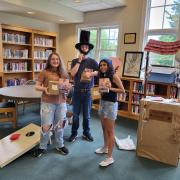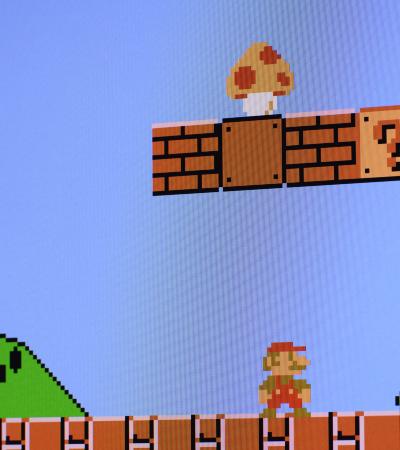The Oregon Trail Live Action Simulation challenged teens and young adults to use financial literacy skills and historical knowledge of the Oregon Trail to complete a full simulated run of the historical trail, with references to the original video game.
Advanced Planning
The idea for an Oregon Trail live-action game stemmed from a suggestion to use a real-life board game to engage teens financial literacy skills. At first, games like Life and Risk were suggested, but Oregon Trail was eventually settled on due to its iconic pop-culture relevance and clever historical setting.
The goal of this program was to challenge teens and young adults to use financial planning skills such as budgeting and emergency preparedness to traverse a scaled-down version of the Oregon Trail. The teen librarian created props such as a large dice, trading post, play money, and play food from scrap materials such as cardboard and donated paint. The decision was made to do as much for free using already owned materials and use the grant money allocated toward the program to purchase prizes for the winning team, in order to incentivize participation.
Preparation in terms of creating the props was done over a series of weeks when time could be found during the work day, though the actual time allotted was roughly 14 hours. This time was dedicated to building and painting the props such as the trading post and large die, printing authentic-looking "greenbacks" to be used as play money, sewing play food out of felt, and drawing out oversized playing cards to be drawn for "calamities."
Marketing
The program was marketed in the monthly email newsletter, on Facebook and Instagram and on paper flyers hung up in and outside of the library and distributed throughout town. Members of the library's Teen Advisory Board also marketed it without being asked on their own personal social media pages and through word-of-mouth through their various Summer clubs and activities. Promotion was overall successful, with an interest in the program from parents of young adults.
MLNV has had a consistent struggle in getting teens to the library during the Summer months, as jobs and Summer clubs and sports take priority in the area. However, interest in the program was shown through comments in person and on social media.
Budgeting
The budget for the original program, when applied for in the FINRA grant, was $300. However, since staff members decided to create the entire program from scratch, no money was actually spent and the grant funding was later allocated toward other programs. Staff did end up spending $60 on the program by ordering themed prizes for the first group to complete the Oregon Trail. These prizes included a set of Choose-Your-Own-Adventure Oregon Trail Books and an ox-shaped piggy bank, so as to represent both the historical setting and financial literacy theme.
Day-of-event Activity
Since most of the prep work, including in-depth historical research, was done weeks ahead of time, day-of-event set-up took roughly 30 mins.
Large foam tiles, already present and previously being used for floor storytimes, were used to mark out the game board. Some pieces were marked as real forts along the trail, such as Fort Kearny and Fort Laramie. Others were marked as rivers where players would need to pay to cross. The Trading Post was stocked with play food, paper cut-outs representing spare parts, small recycled bottles representing medicine, and bean bags representing ammo for hunting purposes. A paper was marked with tallies to indicate how many oxen each party had. Players were to be given bags to keep all their supplies in.
Each group was allocated $1,000 in greenbacks, a historical currency implemented only a few years after the Oregon Trail. Bills were printed on cardstock in $20, $50 and $100 denominations so players could have practice exchanging money and receiving change.
Program Execution
The program began by dividing the eight attendants into two parties. Each party was allocated $1,000 in greenbacks in random denominations. A staff member was stationed at the trading post to sell goods. Original prices of materials were $200 per oxen, $20 per 5 ammo, $100 per spare part, $50 for medicine and $20 for ten food rations.
Players debated with their teams and then spent some of their money on what they would need: 2 oxen were needed to pull their wagon and begin the game, a player had to sacrifice one food ration each to roll the die and take a turn, and other items such a medicine were needed in case players ran into calamities. Each turn, a party rolled the die. Sides were marked with numbers one-three, and "Calamity." Players either moved that number with their party or had to draw a Calamity Card. Calamities included a party member getting an illness such as dysentery, the party facing extreme cold or a thief stealing some of their supplies. A party could also choose not to roll and instead hunt for food, which was simulated via cornhole. Each bean bag in the hole meant five extra food rations.
Calamities could be resolved by using supplies. Medicine could cure a sick party member, etc. If adequate supplies were not available, however, party members would die or be set-back, depending on the circumstance. Party members who did die were given a homemade button stating how they perished, which players found very fun. Dead party members could not help alive ones but had fun heckling the other team. Parties who landed on a River space had to either sacrifice wagon parts or pay a toll to cross. Parties who landed on a fort could choose to buy new supplies or trade in their supplies for others, depending on what they needed. However, prices gradually rose along the trail in order to present a challenge. Rivers and forts were spaced along the trail to reflect the actual Oregon trail route as accurately as possible.
The program, though attended by only eight individuals, was a success. Although no one was encouraged to dress up, one player did wear a bonnet, and another came in an Abraham Lincoln costume. Players had a lot of fun during the game, and many had actually read up on the Oregon Trail prior to coming since they knew there would be references to both the video game and the actual trail. Many of them had actually played the game as part of a school lesson and were excited to see the references to the game and the aesthetic choices made for the game that reflected the low-res, 8-bit style.
They found the prizes fun, though many of them said they came because the actual gameplay and activity looked fun and unique. Interestingly, a large portion of the gameplay was actually dedicated to budgeting. Each party spent a great deal of time budgeting what they would need to buy before setting off on the trail, and what they would save if they needed it later. This was therefore a success in terms of financial literacy and was much in the spirit of the original video game. The library plans to repeat the program during the school year and attempt to partner with the local schools to encourage their students to register when they teach the Oregon Trail and related history in class.
Advice
Launching the program during the summer was probably not the best idea, as there tends to be a decrease in teen patrons during this time. However, there is always a major uptick in child patrons, and it would be valuable to evaluate and simplify this program in order to make it appeal to younger audiences.
Another piece of advice is to over-prepare. Although we prepped over 200 food ration props, these ended up not being enough and we had to cut up some paper to act as last-minute props. Originally, the program was meant to be held outside as the weather was nice, however, the weather was exceptionally hot that day and we had to move it to our front room. Space was therefore tight, so it's best to plan for last-minute changes.
Supporting Materials
- Feedback (Coming Soon!)
- Programming Librarian Facebook Group






